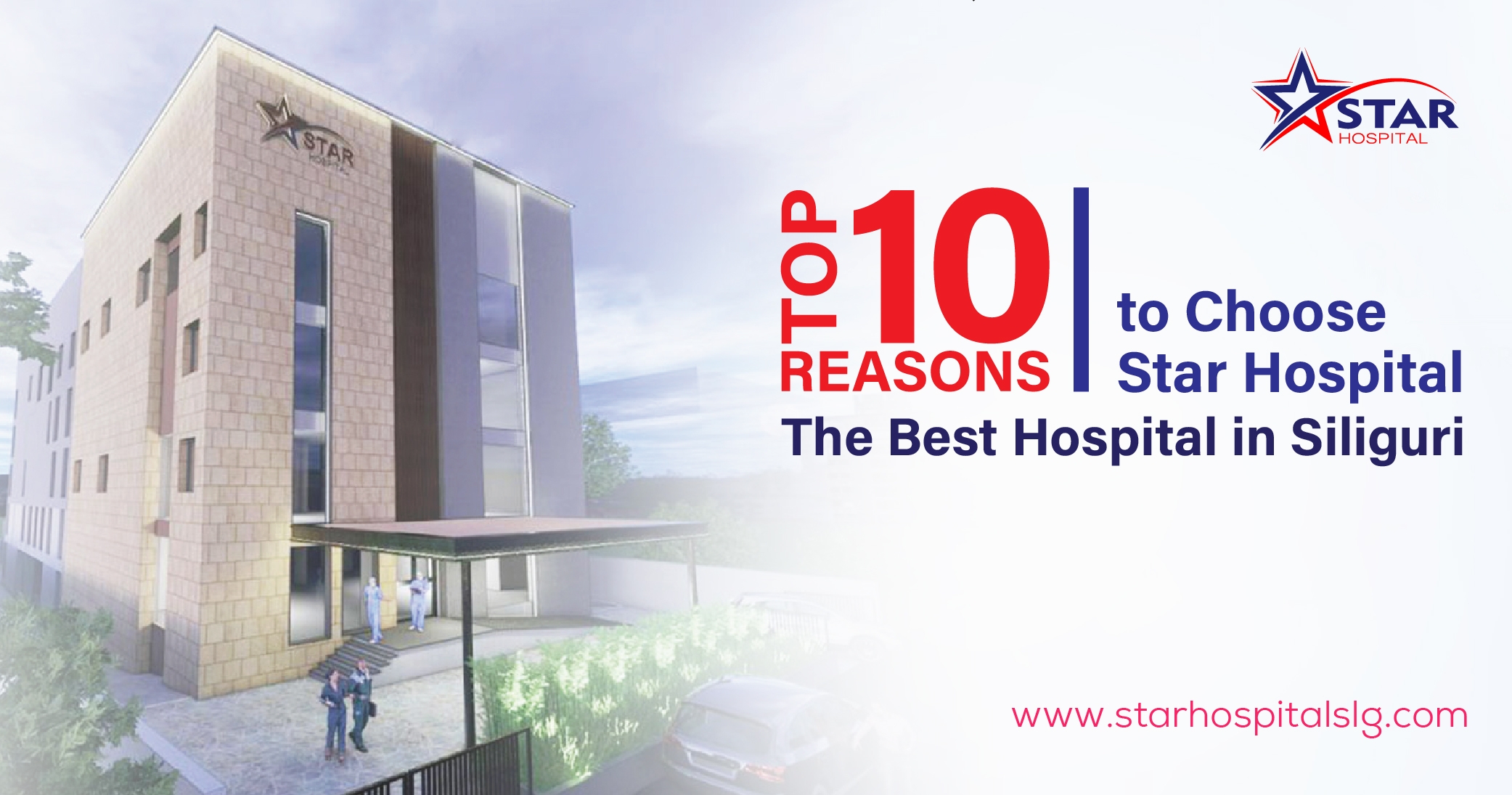Stroke healing is a process that calls for commitment and a professional knowledge. Physiotherapy is an essential part of the rehabilitation process for stroke victims, helping them regain their strength and mobility. Dr. Anmol Chhetri, the leading physiotherapist at Star Hospital Siliguri—the best multispecialty hospital in Siliguri—has extensive experience in rehabilitative care, particularly in the ICU and acute care setup, where early intervention can make a life-changing difference. This blog explores how physiotherapy aids in stroke recovery, especially in ICU and acute care, emphasizing the expertise and techniques Dr. Chhetri uses to make sure patients get the finest results.
Comprehending Stroke Rehabilitation
A stroke damages the parts of the brain that control muscle movement, balance, and coordination by interfering with blood flow. Weakness, lack of mobility, and trouble carrying out simple chores might arise from this. By enhancing muscle tone, coordination, and balance, physiotherapy seeks to restore function while stopping additional difficulties, especially during the early intensive care and acute care stages. Dr. Chhetri is here at Star Hospital Siliguri, is one of the best physiotherapist in Siliguri, that focuses on individualized stroke therapy to optimize recovery and regain independence.
Early mobilization after a stroke is crucial in rehabilitation, especially in the ICU or acute care setup. Starting movement exercises as soon as possible promotes blood flow, prevents muscle atrophy, and stimulates the nervous system, which can play a significant role in aiding recovery of consciousness and cognitive function.
By stimulating the stroke-affected areas, early mobilization improves alertness, reaction, and awareness over time, causing change in the Glasgow Coma Scale (GCS) scores.
Once steady, it is easier to begin therapy because simple exercises maintain joint flexibility and muscle strength. Early mobility also decreases the typical consequences that happens with the patients. All things taken into consideration, it promotes cognitive recovery while accelerating physical repair of the affected parts.
Early ICU Intervention: An Essential Step
Because stroke patients have limited movement and poor health, they require special care. Starting therapy as soon as possible helps avoid any complications which may arise like breathing problems, joint stiffness, and muscle loss. Physiotherapists, use specialized methods that cover respiratory and physical treatment. In order to set the groundwork for future healing, this early stage also places a high priority on passive workouts, posture corrections, and limb placement.
ICU Tools and Methods for Rehabilitating Strokes
Physiotherapists utilize specialized equipment to help stroke patients recuperate in an intensive care unit. Techniques and resources which are used are:
Exercises known as passive range of motion (PROM) involve soft motions that are performed to the patient's limbs to promote circulation and avoid stiffness. In the early phases, when the patient might not be able to move on their own, PROM exercises are crucial.
Electric muscle stimulators (EMS) helps to stimulate muscles in immobilized limbs, thus promoting blood flow and preventing muscle loss. It is vital in preserving muscle health for stroke patients.
Postural Drainage and Respiratory Exercises: For stroke patients, especially serious patients, respiratory physical therapy is very essential. Lung infections, a frequent risk in the intensive care unit, can be avoided with the use of techniques such postural drainage, percussion, and vibration.
Tilt tables: To help with early weight-bearing, these tables progressively raise a patient from a supine posture to a standing one. This process helps stroke patients regain blood flow, increase their tolerance level, and promote their standing exercises.
Mirror therapy:It shows the healthy limb's reflection in a mirror, giving the impression that the injured limb is moving. It tricks the brain in helping with pain relief, which is very helpful when recovering from a stroke.
Constraint-Induced Movement Therapy (CIMT):It requires limiting the movement of the unaffected limb. By encouraging brain adaptability and recovery which hereby enhances strength and function, particularly after a stroke.
According to Dr. Chettri, physiotherapy in intensive care units (ICUs) involves more than just movement; it also adapting to each patient's individual medical requirements and creating a secure atmosphere for healing.
Physiotherapy's Function in Stroke Patients' Acute Care
Physiotherapy is very crucial to the patient's recovery after they are transferred from the ICU to the acute care unit. Restoring strength, balance, and coordination is the main goal, which hereby requires the patient to participate more actively. Customized plans that are regularly monitored to guarantee gradual recovery and adaptation to physical challenges are the main aim of the department.
Important Methods for Acute Care Rehabilitation
In acute care, physiotherapists use the latest methods and tools to help patients recover even more. Among them are:
Exercises for Active Range of Motion (AROM): These exercises help patients begin using their limbs on their own. Its an advanced version of PROM, which hereby aids in regaining voluntary mobility in weak muscles.
Strength Training Equipment: To start enhancing muscle strength in the regions most impacted by the stroke, weight-based and resistance equipment is introduced in acute care. Resistance bands, therapeutic bands, and light weights are commonly used for the treatment.
Gait Training using Walkers or Parallel Bars: Gait training is introduced for patients who are ready to begin walking. Physiotherapists assist patients in relearning fundamental motions, while walkers and parallel bars offer the support they require. This helps in the movement confidence, balance, and coordination of the patient.
Functional Training: Activities such as standing, sitting, and reaching are among the tasks that are emphasized by the doctor. Exercises for functional training are intended to get patients ready for independent living after their treatment.
Balance Training Equipment: Balance boards and stability exercises are used to improve a patient's overall balance, while lowering their chance of falling and helping them restore their confidence while moving.
Equipment for Specialized Physiotherapy in Stroke Recovery
Dr. Chhetri uses the latest equipment in stroke therapy that has been chosen to meet each patient's unique needs:
Rehabilitation Treadmills with Harness Support: When patients start gait training, these customized treadmills with harness support offer support. The harness minimizes fall risk and offers stability as patients start to regain walking ability.
Robotic Assisted Therapy: Star Hospital Siliguri uses robotic devices for repetitive, controlled movements, allowing the patient to improve muscle memory and coordination in a guided manner.
Functional Electrical Stimulation (FES): It improves mobility and function by stimulating nerves to promote movement in muscles damaged by a stroke.
The Principal Benefits of Physiotherapy for Stroke Recovery
Enhanced Strength and Mobility: By allowing the affected limbs to move again, physiotherapy aids patients in regaining their strength, balance, and overall coordination.
Prevention of Complications: Prompt action, particularly in ICU, can avoid breathing problems, joint stiffness, and muscle atrophy, all of which can delay healing during the recovery period.
Improved Quality of Life: Consistent progress increases pride, mental well-being, and a feeling of empowerment.
Commencing Physical Therapy after a Stroke: Immediate action increases the likelihood of recovery. Families should speak with specialists at Star Hospital Siliguri, which provides the latest ICU and acute care treatment, Dr. Chhetri suggests. Prompt, customized treatment helps
in accelerating healing and minimizing problems that arises.
Why choose Siliguri's Star Hospital?
For stroke therapy, it’s crucial to find a skilled physiotherapist. Dr. Anmol Chhetri, among the best physiotherapists in Siliguri, leads a dedicated team at Star Hospital Siliguri, the city’s top multispecialty hospital, to help patients regain independence and quality of life. His focus on personalized care and the latest technology makes him an excellent choice for stroke recovery.





